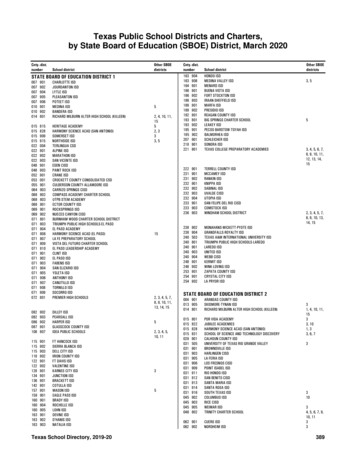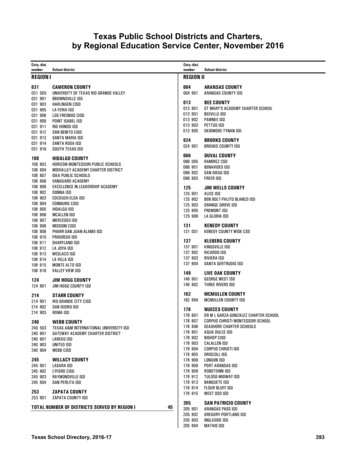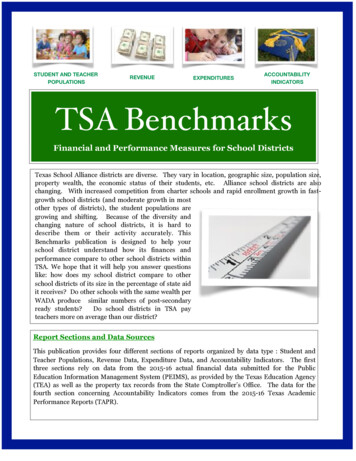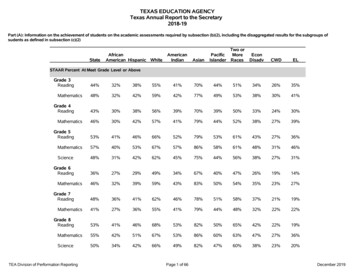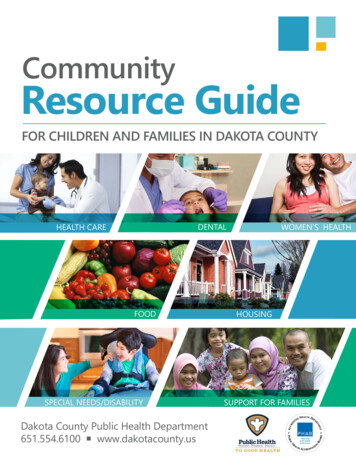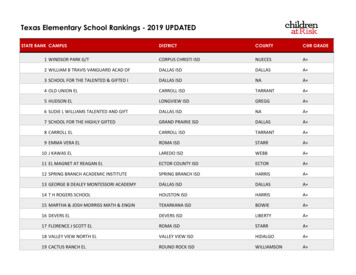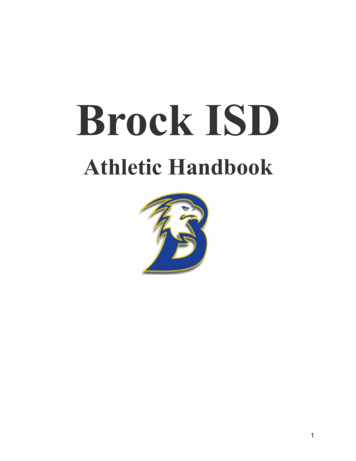
Transcription
Brock ISDAthletic Handbook1
Brock Independent School District has established itself as having an extremelycompetitive, highly recognized and well-respected athletic department. This reputationfor excellence takes the diligent efforts of coaches, student athletes, parents,community supporters, and administration.Brock ISD offers a wide range of athletic programs for secondary students. Programsvary by grade level but include baseball, basketball, cheer, cross country, football, golf,powerlifting, softball, track and field, tennis and volleyball.The mission and goals of the Brock ISD athletics program is to help provide our studentathletes the ability to develop an appreciation for academics, attitude, integrity, workethic and personal accountability.This handbook is designed to provide for a successful experience for student athletesand the efficient operation of the Brock Independent School District Athletic Program.The athletic handbook is designed to co-exist with the BISD Student Handbook, and theBISD Student Code of Conduct. Student-athletes in grades 7-12 are accountable andresponsible to the rules and requirements contained within this handbook.It should be noted that different sports might have additional rules and regulations thatgo beyond what is listed in this athletic handbook. These rules may be in addition to thisathletic handbook, but they shall not alter the rules of this handbook.Eligibility for initial and continuing participation in many of these activities is governed bystate law and the rules of the University Interscholastic League (UIL)—a statewideassociation overseeing interdistrict competition. If a student is involved in an academic,athletic, or music activity governed by UIL, the student and parent are expected to knowand follow all rules of the UIL organization. [See http://www.uiltexas.org for additionalinformation.] The following requirements apply to all extracurricular activities:2
UIL ATHLETIC CODE FOR COACHESThe code for athletic sponsors includes the principles and purposes of high schoolathletics as listed in the Constitution and Contest Rules Section 1201 (b). Each coach inthe BISD must follow the letter, as well as the spirit of these rules. It is throughdemonstrating the expectations that student-athletes best learn, and it is the policy ofBISD that all coaches demonstrate the highest standards regarding this code. Eachcoach is responsible for:1. Being aware of, understanding, and following all rules governing the competition forwhich the coach is responsible.2. The coach must inform their immediate supervisor, the next school day after acontest if a player or coach is ejected from that contest or in football, if one is given two15-yard unsportsmanlike penalties during one contest, knowing that such conduct willreceive an automatic penalty.3. Treating athletes based on what is best for the education, general welfare, and healthof the student.4. Displaying professional loyalty to other coaches.5. Adhering to in-season and out-of-season practice regulations.6. Adhering to policies that do not force athletes to specialize or restrict them fromparticipation in other sports.7. Abstaining from any practice that would bring financial gain to the coach by using astudent’s participation or BISD facilities in a camp, clinic, league, or other non-schoolathletic event, not approved by BISD administration.8. Avoiding any coaching practice that would endanger the welfare or safety of anyplayer.9. Emphasizing the academic progress of all participants by a regular, documentedcheck of their academic standing, both in season and out of season.10. Avoiding any actions that encourage, condone, or tolerate the use of performanceenhancing drugs by any student athlete.3
Emergency Action PlanBrock ISD Athletics**In case of an emergency, personnel responsibilities, locations of emergency equipment, and other emergencyinformation such as 911 call instructions, addresses/directions to the venue, and a chain of command withimportant phone numbers have been listed here**Table of ContentsPersonnel Involved in DevelopmentIntroductionEmergency PersonnelActivating EMS/Emergency CommunicationMedical/Emergency Transportation Post EAP Activation ProcedureStaff Education/ConclusionChain of Command/Emergency Contact InfoEAP DiagramEmergency Equipment LocationsManagement of Specific Conditions AsthmaSevere Allergies/AnaphylaxisDiabetesHeat IllnessesCold Weather PolicyGeneral Plan of Action Verification of Acknowledgement4
Personnel Involved in DevelopmentThe following individuals were involved with the creation of this Emergency Action Plan: Greg Connors LATHead Athletic Trainer(325) 315-8411 Tara Morano MSAT, LAT, ATCAssistant Athletic Trainer(512) 748-3591 Chad MasseyAthletic Director(817) 597-55725
IntroductionEmergency situations may arise at any time during athletic events. Immediateaction must be taken in order to provide the best possible care to the studentathlete. The development and implementation of an emergency action plan willhelp ensure that the best care will be provided.As emergencies may occur at any time and during any activity, all school activitiespersonnel must be prepared. Athletic organizations have a duty to develop anemergency action plan that may be implemented immediately when necessaryand provide appropriate standards of emergency care to all sports participants.This preparation involves formulation of an emergency action plan, propercoverage of events, maintenance of appropriate emergency equipment andsupplies, utilization of appropriate emergency medical personnel, and continuingeducation in the area of emergency medicine and planning. Through carefulpreparticipation examinations/physical screenings, adequate medical coverage,safe practice and training techniques and other safety avenues, some potentialemergencies may be averted. However, accidents and injuries are inherent withsports participation, and proper preparation on the part of the sports medicineteam should enable each emergency situation to be managed appropriately andefficiently.Components of an Emergency Action Plan1.2.3.4.5.Emergency PersonnelEmergency CommunicationEmergency EquipmentRoles of First ResponderVenue Directions6
Emergency PersonnelThe first responder in an emergency situation during an athletic practice orcompetition is typically a member of the sports medicine staff, such as a certifiedathletic trainer. However, the first responder may also be a coach or anothermember of the school district.Certification in cardiopulmonary resuscitation (CPR), first aid, automated externaldefibrillator (AED), and emergency action plan review is required for all athleticspersonnel associated with practices, competitions, skills instruction, and strengthand conditioning. All coaches are required to have CPR, First Aid, and AEDcertifications.The emergency team may consist of physicians, emergency medical technicians,certified athletic trainers, athletic training student aides, coaches, managers, andpossibly even bystanders. Roles of these individuals will vary depending ondifferent factors such as team size, athletic venue, personnel present, etc.The four basic roles within the emergency team are: Establish scene safety/immediate care of athlete This should be provided by the most qualified individual on the medical team(first individual in chain of command) Activation of EMS This may be necessary in situations where emergency transportation is notalready present at the sporting event. Time is the most critical factor and thismay be done by anyone on the team. Equipment Retrieval May be done by anyone on the emergency team who is familiar with thetypes of locations of the specific equipment needed. Direction of EMS to Scene One of the members of the team should be in charge of meeting theemergency personnel as they arrive at the site. This person should have keysto locked gates/doors.7
Activating EMS Call 9-1-1 & provide the following information. Name/Call Back Number Nature of Emergency Number/Condition of Athletes Involved Treatment being rendered Specific directions needed to locate emergency scene Other information requested by the dispatcher. DO NOT HANG UP FIRSTEmergency CommunicationCommunication is the key to a quick, efficient emergency response. There is apre-established phone tree to ensure all relevant parties are notified. Access to aworking telephone line or other device, either fixed or mobile, should be assured.There should also be back-up communication in effect in case there is a failure ofthe primary communication.Medical/Emergency TransportationAny emergency situation where there is suspected C-Spine injury, impairment ofairway, breathing, or circulation (ABCs) or there is a neurovascular compromiseshould be considered a “load and go” situation and emphasis is placed on rapidevaluation, treatment, and proper transportation. Any emergency personnel whoexperiences doubt in their mind regarding the severity of the situation shouldconsider a “load and go” situation and transport the individual.Discretion can be made by qualified personnel regarding transportation situationsin certain instances not to be considered “life threatening” due to the proximity ofthe hospital to certain athletic venues.8
Post EAP Activation ProceduresDocumentation and debriefing should be done by involved personnel and theathletic trainer in order to determine if any modification or adjustments to theEmergency Action Plan needs to be made.Staff Education1. Each season, every new coach will need to review the Emergency ActionPlan (EAP). If any changes are made, every coach will be asked to review theEAP again.2. A copy of the relevant EAP will be located in each of the athletic trainingrooms.ConclusionThe importance of being properly prepared when athletic emergencies arisecannot be stressed enough. An athlete’s survival may hinge on the training andpreparation of healthcare providers. It is prudent to invest athletic departmentownership in the emergency action plan by involving athletic administration,coaches, as well as sports medicine personnel. The emergency action plan shouldbe reviewed at least once a year by/with all athletic personnel. And localemergency response teams. Through development and implementation of theemergency action plan, Brock ISD helps ensure that all athletes will have the bestpossible patient centered care that can be provided when an emergency situationdoes arise.9
Chain of CommandThe athletic training staff should always act as primary care-givers at the site ofinjury or accident (when on-site) and manage the situation according to thefollowing rank:1.2.3.4.Athletic TrainerHead CoachAssistant CoachAthletic Director/Administrator**Athletic Training Student Aides can assist but should not provide care**Emergency Contact InformationOff Campus ContactsPhone NumberEmergency9-1-1Brock Fire Department(817) 341-7368Parker County Police Department(817) 594-8845On Campus ContactsPhone NumberGreg Connors - Head Athletic Trainer(325) 315-8411Tara Morano - Assistant Athletic Trainer(512) 748-3591Chad Massey - Athletic Director(817) 597-5572Melissa Burden - District Nurse(817) 851-6791Andy Hudson - Junior High Principal(817) 304-6293Eric Sams - High School Principal(817) 629-5145Dee Ann Mills - Superintendent(817) 597-815810
EAP Diagram - Athletic Trainer Not Present11
Emergency Equipment:Athletic training kit, AED, splint bag, crutches, Biohazard/First Aid Kit on site for events coveredby Athletic TrainerEmergency Equipment Locations1. AEDa. Portable AEDs will be stored in each ATR. Will be located with Athletic Trainer for allcovered events (sidelines)b. High school: east end of the fieldhouse, in gym (lobby side), concession stand ofbaseball/softballc. Junior high: outside of new gym facing trackd. Athletic Trainer’s personal cell phone when covering eventse. Coaches’ personal cell phonesf. Athletic Training Student Aides will carry personal phones2. Splintsa. Splint bags will be stored in ATR but kept on the sideline for all covered events.3. Spine boards/Cervical Collara. Will be provided by EMS upon arrival4. Biohazard Materialsa. Red bags – located in ATRb. Disposal Bin – in ATR12
Management of Specific Conditions- Asthma Student athletes with asthma need to be identified and noted prior to the season. Level of severity, type of asthma, triggers and independence in management also needto be noted Each student athlete with asthma is responsible for bringing their inhaler with them to allpractices/games (not doing so may result in not being allowed to participate). Nebulizers may be required for students with uncontrolled asthma in the event they do not havean inhaler. Each student must leave an inhaler with Athletic Trainer/coaches available during practices andgames (not left in a personal bag). Must be labeled with a name. Proper education and instruction on medication and management may be necessary Inform students necessity to take inhaler 15-20 minutes prior to the physical activity Certain environmental conditions in which there is a high level of allergens in the air may because for practice to be moved inside in an attempt to prevent asthmatic episodes (discretion ofathletic trainer)-----------------------------------IN THE EVENT OF AN ASTHMATIC EPISODE----------------------------------1. Use pulse oximeter to determine level of oxygen saturation Anything below 95% should be considered abnormal Anything below 90% should be considered an emergency2. Administer authorized medication as directed and inform parents3. Monitor student athlete4. Return to activity is at discretion of athletic trainer5. SEEK EMERGENCY MEDICAL CARE IF STUDENT: No improvement or decline after initial treatment (15-20mins) Trouble talking Lips/fingernails turn gray/blue13
Management of Specific ConditionsSevere Allergies /Anaphylaxis Student athletes with severe allergies need to be identified and noted prior to season Management, triggers, medications used need to be also notedEpiPen Each student who has an epi pen is responsible for bringing their epi pen with them toall practices/games Epi pen must be left with Athletic Trainer (labeled with name) during practices andgames (not left in personal bag). Athletic trainer may be given a backup Epi pen by the parent or child to keep as a backupin the med kit/ATRIf a child has ANY of these severe symptoms after eating the food or having a sting, giveepinephrine. Shortness of breath, wheezing, orcoughingSkin color is pale or has a bluishcolorWeak pulse Fainting or dizzinessTight or hoarse throatTrouble breathing or swallowingSwelling of lips or tongue thatbother breathingMany hives or redness over bodyAny student athlete that experiences some form of anaphylaxis, Epi pen should be administered,followed by the steps listed below1. Inject epinephrine right away! Note the time when epinephrine was given.2. Call 911. Ask for an ambulance with epinephrine. Tell the rescue squad when epinephrine was given.3. Stay with child and: Call parents Give a second dose of epinephrine, if symptoms get worse, continue, or do notget better in 5 minutes. Keep child lying on back or side4. Give other medicine, if prescribed. Do not use other medicine in place of epinephrine.Anaphylaxis is a potentially life-threatening, severe allergic reaction. If in doubt,give epinephrine.14
Management of Specific Conditions- Diabetes ID all student athletes with diabetes and determine level of independence inmanagement. Ensure that there is a proper personalized care plan in place by parents orathletic trainers including ways to monitor blood glucose (BG), insulin guidelines,treatment guidelines and emergency contact information.Hypoglycemia Any diabetic athlete who displays signs/symptoms of hypoglycemia will be evaluated andtreated accordingly. Symptoms are: tachycardia (fast heart rate), sweating, palpitations, hunger,nervousness, headache, trembling, or dizziness Athletes found to be suffering from mild hypoglycemia (athlete is conscious andable to swallow) will be given glucose tablets and have BG checked. Coaches/AT staff should administer any of the following when mildhypoglycemia is suspected: glucose tablets, apple juice, raisins, honey EMS will be activated for those suffering from severe hypoglycemia (unconscious).Hyperglycemia Any diabetic athlete who displays signs/symptoms of hyperglycemia without ketosis willbe evaluated and treated accordingly. Symptoms are: nausea, dehydration, reduced cognitive performance,sluggishness, fatigue An athlete who has a fasting blood glucose level of 300 mg/dL without ketonescan continue to exercise with frequent reassessment of blood glucose levels. A diabetic athlete who displays signs/symptoms of hyperglycemia with ketoacidosis(Kussmaul breathing- abnormally deep and rapid breathing, breath that has a fruityodor, unusual fatigue, sleepiness, loss of appetite, increased thirst and frequenturination, as well as previously listed symptoms) will be evaluated and treatedaccordingly. Remove from activity until further testing can be done.Any diabetic athletes who are pulled out of activity should demonstrate anormal blood glucose level and be evaluated by an athletic trainer before beingpermitted to return to play.15
General Plan of Action1.2.3.The most medically qualified person will lead.Check the scene – is it safe to help?Is the athlete breathing? Conscious? Pulse? NO: instruct someone to call 911 – LOOK PERSON DIRECTLY IN EYES andmake sure they understand.4.Perform emergency CPR/First Aid If severe bleeding – instruct individual to assist with bleeding control5.Instruct separate coach/bystander to get AED and control crowd Head Coach will stay with athletic trainer to assist Assistant coaches/coordinators will be in charge of crowd control andanything else needed6.7.8.9.10.11.Contact the Athletic Trainer if they are not on scene.Contact parentsContact administratorInstruct someone to meet the ambulance and direct to incident siteAssist with care as necessary.Document event/debrief16
Emergency Action Procedures - Field SportsActivate the EAP: Suspected spine injury Open/abnormal fracture Difficulty/absent breathing or pulse Uncertainty of if you have a medical emergencyEmergency Personnel:Brock ISD Athletic Trainer will be on site for select practices and events or in direct communicationwith coaching staff. Emergencies during practices/games not covered, EMS should be contactedimmediately.Emergency Procedures:1) Check the scenea)Is it safe for you to help?b)What happened?c)How many victims are there?d)Can bystanders help?2) Instruct coach/bystander to call 911-Provide the following information Name/Call Back Number Nature of Emergency Number/Condition of Athletes Involved Treatment being rendered Specific directions needed to locate emergency scene Other information requested by the dispatcher. DO NOT HANG UP FIRST3) Perform emergency CPR/First Aida)Check airway/breathing/circulation, level of consciousness, and severe bleeding.i. If an Athletic Trainer is present, he/she will stay with the athlete and provideimmediate care.ii. If an Athletic Trainer is not present, most qualified coaches (training/certifications)will stay with the athlete and provide immediate care.b)Instruct coach/athletic training student aide/bystander to GET AED!!4) Designate coach or administrator to control crowd5) Contact the Athletic Trainer if not present on scene6) Designated someone to meet ambulance and direct to appropriate sitea) Open Appropriate Gates/Doors7) Assist AT and/or EMS with care as directeda) Retrieve Necessary Supplies/Equipment8) Document event and debrief17
Emergency Action Procedures - High School Gym SportsBrock High School is located at 400 Eagle Spirit Lane Brock, Weatherford, TX 76087Activate the EAP: Suspected spine injury Open/Abnormal fracture Difficulty/absent breathing or pulse Uncertainty of if you have a medical emergencyEmergency Personnel:Brock ISD Athletic Trainer will be on site for select practices and events or in direct communicationwith coaching staff. Emergencies during practices/games not covered, EMS should be contactedimmediately.Emergency Procedures:9) Check the scenea)Is it safe for you to help?b)What happened?c)How many victims are there?d)Can bystanders help?10) Instruct coach/bystander to call 911-Provide the following information Name/Call Back Number Nature of Emergency Number/Condition of Athletes Involved Treatment being rendered Specific directions needed to locate emergency scene Give the address listed above, park in front of the high school and enter through themain doors. There will be someone to meet them at the front door. Go through thelobby and into the gym. Other information requested by the dispatcher. DO NOT HANG UP FIRST11) Perform emergency CPR/First Aida)Check airway/breathing/circulation, level of consciousness, and severe bleeding.i. If an athletic trainer is present, he/she will stay with the athlete and provideimmediate care.ii. If an athletic trainer is not present, most qualified coaches (training/certifications)will stay with the athlete and provide immediate care.b)Instruct coach/athletic training student aide/bystander to GET AED!!12) Designate coach or administrator to control crowd13) Contact the Athletic Trainer if not present on scene14) Designated someone to meet ambulance and direct to appropriate sitea) Open Appropriate Gates/Doors15) Assist AT and/or EMS with care as directeda) Retrieve Necessary Supplies/Equipment16) Document event and debrief18
Brock ISD Cold Weather GuidelinesCold weather is defined as any temperature that can negatively affect the body’sregulatory system. These do not have to be freezing temperatures. The followingtemperature guidelines have been established for Brock ISD Athletic Departmentpractices and games.Cold Weather Caution: When temperature or wind chill (which is lower than actualtemperature) is from 40 F- 30 F- No modification of practice, but a warning will be given to coaches and athletes- Coaches and Athletic Trainers emphasizing the importance of following UIL ColdWeather IllnessRecommendations.- Watching those “high risk” athletesCold Weather Warning: When temperature or wind chill is from 30 F - 20 F, theremay be a modified outside participation of 45 minutes.- warm-up to be started indoors (stretching, etc.) to not take away from 45 min.- a practice that keeps individuals moving, try to avoid working up a big sweat in the first20 minutes then having them be doing nothing.- Wearing a hat that covers the ears, and some sort of gloves to cover the hands arerequired. - Keeping a very close eye on those “high risk” athletes- If available, a cool-down indoors.Cold Weather Termination: When temperature or wind chill reaches 19 F and below,there may be a termination of outside practices and games.19
UIL Cold Weather Illness InformationHypothermia: Hypothermia is a decrease in core body temperature.1. Mild Hypothermia - shivering, cold sensation, goose bumps, numb hands.2. Moderate Hypothermia - intense shivering, muscle incoordination, slow andlabored movements,mild confusion, difficulty speaking, signs of depression, withdrawn.3. Severe Hypothermia - shivering stops, exposed skin is bluish and puffy, inabilityto walk, poormuscle coordination, muscle rigidity, decrease in pulse and respiration rate,unconsciousness. Management:o Removeathlete from cold environments.o Removewet clothing and replace with dry clothing and/or blankets.o Referall moderate cases to the emergency room once safe to transport.o Treatsevere hypothermia as a medical emergency! Wrap the athlete in an insulatedblanket and seek emergency medical care immediately.FROSTBITE. Thermal injury to the skin caused by cold exposure.1. Frostnip - skin appears white and waxy or gray and mottled; possible numbness andpain.2. Superficial Frostbite - skin appears white, mottled or gray; feels hard or rubbery butdeeper tissue is soft, insensitive to touch.3. Deep Frostbite - skin is white and has a wooden feel, numbness and anesthesia.Management:Do not rub the area. Gently rewarm the area by blowing warm air onto the area, placing thearea against awarm body part, or placing the affected area into warm (101 - 108 degreesF) water for several minutes. If not absolutely certain that the tissue will stay warm after rewarming, donot rewarm it. If a person is also suffering from hypothermia, the first concern is corerewarming.Prevention: The best method of management is prevention. 20
Dress in layers. Cover the head to prevent excessive heat loss from the head and neck. Stay dry by wearing a wicking fabric next to the body and a breathable, waterrepellent outer layer. Stay adequately hydrated. Eat regular meals. Educate participants, coaches, officials and administrators in recognition ofcold-related illnesses. Consider cancellation of athletic events if weatherconditions warrant.Brock ISD Hot Weather GuidelinesHigh temperatures put student athletes at increased risk of heat illness. There are several types of heatillness. They range in severity, from heat cramps and heat exhaustion, which are common but not severe,to heat stroke, which can be deadly. Although heat illnesses can be fatal, death is preventable if they’requickly recognized and properly treated.When players are practicing or competing, coaches should follow the following steps to help preventheat-related illnesses: Allow 10-14 days for adjusting to warmer climate/temperatures Reduce intensity and/or length of training with high temperatures and/or humidity Schedule practice during cooler times of day Schedule and enforce frequent drink breaks and rest periods Remove pads and practice in T-shirts and shortsAT A DRY BULB TEMPERATURE READING OF 99 OR LESS WITH A HEAT INDEX OF 105 OR LESS: Normal practice conditions with usual breaks, unlimited access to water.AT A DRY BULB TEMPERATURE READING OF 100 - 102 OR A HEAT INDEX OF 106 - 110: Athletes will continue to be given unlimited access to water and more frequent breaks. Cross country must stay on campus and limit run length. High school football practice no outdoor conditioning. All outside workouts for indoor sports suspended. All outside workouts for Junior High Athletics Suspended. Practice may be movedinside or resumed later in the evening when dry bulb and heat index reach allowablelevels.AT A DRY BULB TEMPERATURE READING OF 103 - 105 OR A HEAT INDEX OF 111-115: Shorter periods of activity with unlimited access to water and additional frequent breaks High school football practice should take place without shoulder pads and no conditioningAT A DRY BULB TEMPERATURE READING OF 106 OR A HEAT INDEX OF 116 AND GREATER: All outdoor workouts suspended. Practice may be moved inside or resumed later inthe evening when dry bulb and heat index reach allowable levels.21
Management of Specific Conditions- Heat IllnessesHeat Cramps: Painful spasms usually in the muscles of legs and abdomen, accompanied byheavy sweating. Management: Firm pressure on cramping muscles or gentle massage to relieve spasms. Givesips of water. If nausea occurs, discontinue water.Heat Exhaustion: Symptoms range in severity from mild heat cramps to heat exhaustion topotentially life-threatening heatstroke. Heat exhaustion can begin suddenly, usually afterworking or playing in the heat, perspiring heavily or being dehydrated. Heat exhaustion signs and symptoms include: Faintness or dizziness.Nausea or vomiting.Heavy sweating is oftenaccompanied by cold, clammyskin. Weak, rapid pulse.Pale or flushed face.Muscle cramps.Headache.Weakness or fatigue Remove tight or heavy clothing.Give fluidsCool the person by spraying ortsponging with cool water andfanning.Monitor the person carefully Management: Move the person out of theheat and into a shadyair-conditioned place.Lay the person down andelevate the legs and feetslightly. Heat stroke (or sunstroke): Heat stroke is a severe medical emergency. Summon emergencymedical assistance or get the victim to a hospital immediately. Delay can be fatal! Heat stroke symptoms include High body temperature:A body temperature of 104 For higher is the main sign ofheatstroke.Nausea and vomiting Flushed skinRapid/shallow breathingAltered mental state/behavior:Alteration in sweating: skin canbe hot, dry or moist. Management: Take immediate action to cool the person while waiting for emergency treatment. Getthe person into shade or indoors. Remove excess clothing. Cool the person withwhatever means available—cold tub, ice, cool shower, wet towels. (Cooling places are aperson’s head, neck, armpit, and groin). Cooling should be done until the person’s coretemperature is 102 F or less OR after 10-15 minutes of cooling.Modification of Athletic ActivitiesThe decision to modify and/or terminate a Brock ISD athletic activity in the event of excessive heat22
and/or poor air quality should be made by a member of the BISD Sports Medicine Department inconsultation with the Team Physician and the head coach or his/her designee.Brock ISD Lightning Safety InformationPlease make sure that each coach has the Perry Weather Appinstalled and working if there is ever a possibility of storms.Some information to always follow:If a lightning detection occurs from 8-10 miles on our detector weWILL vacate all fields. This is NOT optional or a judgment call. Thisis a mandate. We will always air on the side of caution.All coaches, trainers, officials or administrators can make the call tovacate the fields but if one field vacates, due to lightning, allfields/courts will need to vacate. If this occurs during a contest wewill need to have an announcement made to the crowd (below) thatthey will need to vacate the area.If we
The first responder in an emergency situation during an athletic practice or competition is typically a member of the sports medicine staff, such as a certified athletic trainer. However, the first responder may also be a coach or another member of the school district. Certification in cardiopulmonary resuscitation (CPR), first aid, automated .

